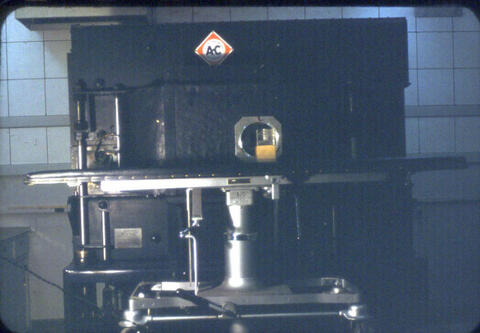
Zona do título e menção de responsabilidade
Título próprio
Betatron
Designação geral do material
- Material gráfico
Título paralelo
Outra informação do título
Título e menções de responsabilidade
Notas ao título
Nível de descrição
Item
Entidade detentora
Código de referência
Zona de edição
Menção de edição
Menção de responsabilidade da edição
Zona de detalhes específicos de materiais
Menção da escala (cartográfica)
Menção da projecção (cartográfica)
Menção das coordenadas (cartográfico)
Menção da escala (arquitectura)
Autoridade emissora e denominação (filatélica)
Zona de datas de criação
Data(s)
-
1948 (Produção)
Zona de descrição física
Descrição física
1 slide : col. ; 6 x 6 cm
Zona dos editores das publicações
Título próprio do recurso continuado
Títulos paralelos das publicações do editor
Outra informação do título das publicações do editor
Menção de responsabilidade relativa ao editor do recurso contínuo
Numeração das publicações do editor
Nota sobre as publicações do editor
Zona da descrição do arquivo
Nome do produtor
História custodial
Âmbito e conteúdo
Image of the betatron.
Bio/Historical Note: In May 1948 Dr. Harold E. Johns, Dr. Newton Haslam, and Dr. Leon Katz, professors of Physics at the University of Saskatchewan, travelled to Milwaukee to inspect the betatron that had been built for the U of S. In August of that same year, the U of S installed in the Physics Annex the first betatron in Canada—the world’s first betatron used for a cancer treatment program. Dr. Johns then began the design and construction of one of the first cobalt-60 teletherapy units. Dr. Johns and his graduate students became the first researchers in the world to successfully treat a cancer patient using cobalt-60 radiation therapy. It was also used for research programs in nuclear physics, radiation chemistry, cancer therapy and radiation biology. In 1951 the world’s first calibrated Cobalt-60 cancer therapy unit was installed at University Hospital (G Wing). The calibration work was done by Dr. Sylvia Fedoruk through rigorous depth dose measurements. In early 1952, Maclean's magazine had dubbed the cobalt-source radiotherapy machine the cobalt bomb - a tongue-in-cheek tribute to this peaceful use of nuclear technology. Dr. Johns’ pioneering work in cobalt-60 teletherapy became the gold standard for radiation therapy for many years and thousands of units were installed worldwide, helping countless patients. The original treatment device was used in Saskatchewan until 1972. The work Dr. Johns and his team did on the physics of high energy photon beams was fundamental, and still forms the basis of most treatment planning systems in use today.
Zona das notas
Condição física
Fonte imediata de aquisição
Organização
Idioma do material
Script do material
Localização de originais
Disponibilidade de outros formatos
Restrições de acesso
Termos que regulam o uso, reprodução e publicação
Photographer: Gibson
Other terms: Copyright: University of Saskatchewan

